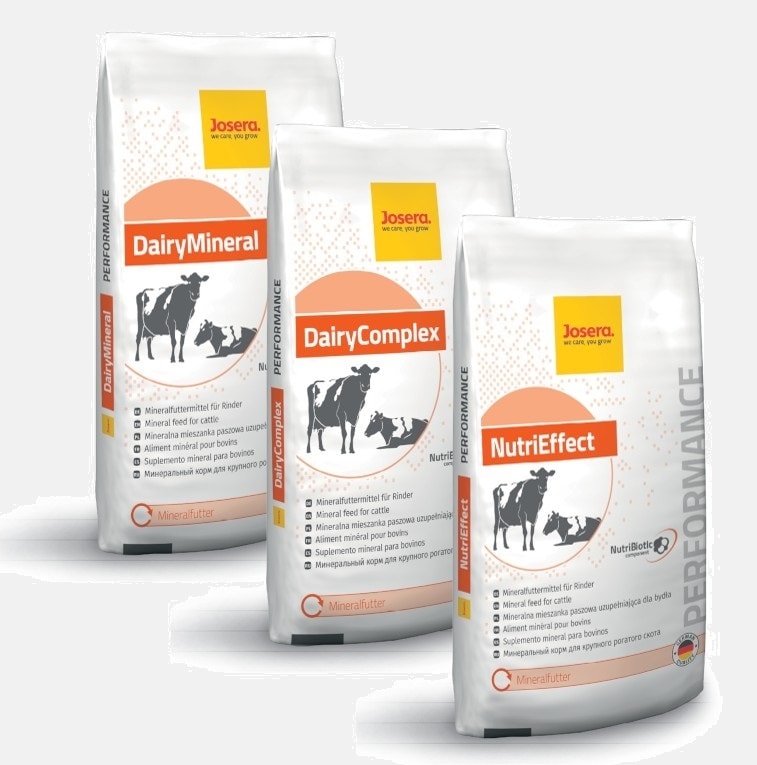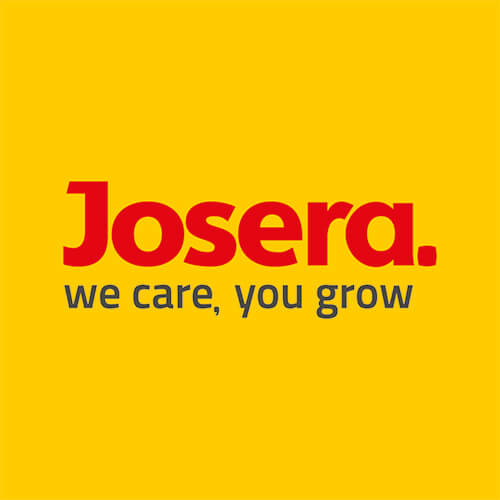What is heat stress?
Cows prefer cooler temperatures. The most comfortable temperature for a cow is between – 5 to + 15 °C.
Unfortunately, temperatures often exceed this range during the summer. But how can a farm manager make the summer months more bearable for his animals?
Rising temperatures put a huge strain on the metabolism. The situation becomes even worse with high humidity. The warmer it gets, the harder it will be for the cow (especially high-performance cows) to release heat directly through the skin. There is no defined limit on when heat stress begins.
Rapid temperature increases or prolonged periods of hot weather typical in summer cause heat stress for cattle. Heat stress is generally recognised by low daily intake and can result in 10 to 35% reduction in milk production. What is often not recognised is the corresponding metabolic cell stress. The cow will attempt to maintain milk production, but with lower feed intake, the energy must come from somewhere – her body reserves. Increased metabolic cell stress associated with mobilisation of body reserves has further reaching impact than just lower milk production. Loss of body score, silent oestrus and poor conception rates are also associated with heat stress.
Symptoms of heat stress in cattle
The first symptoms of heat stress in animals are increased pumping and an increased respiratory rate, which can result in heavy panting with an elongated neck and open mouth.
Animals with heat stress are also less likely to be found lying down, as they are trying to increase their body surface exposed to a draught.
Another symptom is sweating, causing the cow to lose important minerals.
Consequences include diseases such as mastitis, but a drop in milk yield and a deterioration in milk ingredients are also possible effects.
Recover our lick products for a sufficient and high-quality supply of minerals!
Heat stress in calves
Calves can also suffer from heat stress. When temperatures reach 20 °C, they try to stay in the shade and are more likely to be found standing up than lying down.
The symptoms are the same as in adult cows. Calves start to sweat and pant with their mouths open until finally becoming dehydrated. The muscles begin to shake and cramps begin. The body temperature can rise up to 40 °C.
What happens when a cow is suffering from heat stress?
Heat stress leads to:
- Reduced feed intake of the cow
- A decreased amount of milk after a certain time lag
- A decline in milk ingredients
- Poor fertility
- Metabolic disorders which gradually begin to appear
- Health problems such as bovine laminitis and mastitis
Especially during times of energy deficit, in which there are large energy gaps, reduced feed intake often results in ketosis. In addition to the consequences mentioned above, the liver is also heavily strained and reaches the limits of its capacity or even is forced to exceed them.
JOSERA DairySafe
Experience shows that attempts are made to compensate for reduced feed intake by increasing the energy density, usually at the expense of adequate fibre supply. An increased intake of starch and sugar increases the risk of acidosis. There is a decline in ruminating activity, salivation is inhibited, and as a result, the buffering capacity of the rumen decreases.
Acidosis may lead to further problems. The decrease in the pH in the rumen alters the rumen microbiota. There are increasing numbers of enterotoxins. These are distributed around the body via the bloodstream and can lead to conditions including bovine laminitis.

As a farmer, what can I do against heat stress?
The best way to make the summer as comfortable as possible for cows is a well-thought-out combination of feeding technology, management and rationing.
Water. The be-all and end-all is a good water supply. In this case, the demand for water depends on
- the ambient temperature,
- the water content of the feed,
- the amount and structure of the feed
- and the performance level of the animal.
You should use the most efficient cows and the highest annual temperatures as a basis.
The water demand is 4-5 litres per kilogram of dry matter intake and can be up to 180 litres of water per cow in midsummer.
Animals should be offered freely accessible, clear water with no after-taste, and during hot spells extra drinking troughs for less dominant animals should be made available.
Husbandry.
- On the pasture
- Make sure there is enough grazing area in the shade as direct sunlight puts a strain on the cows
- Grazing should be done in the morning and/or evening when it is cooler
- In the stalls Encourage air flow by keeping windows and gates open
- Use fans or water sprayers
- Avoid overcrowding
Feeding.
The feed intake must be maintained.
- Rationing: It is important to use enough structurally effective fibre to maintain the pH of the rumen. If the dry matter of the ration increases due to drying out at the edges of the silo or on the feed alley, consider using water.
- Feed supply: One-time feeding should take place in the cool evening hours. Repeated feed supply and a frequent subsequent topping up have a positive effect on intake. With automatic milking systems in particular, there is a risk of poor intake of staple feed. In this case, the amount of concentrated feed should be reduced on the robots or machines.
What impact does heat stress have on the intestine?
The most measures are limited on reducing external factors or minimising negative effects of heat on silage and ration on the feed table. What has been ignored so far is the connection between metabolism, mucous membranes and intestinal epithelium. Scrientists from the Leipniz Institute have now been able to prove that summer temperatures damage the natural intestinal function of dairy cows. The intestine has a natural protective barrier that prevents bacteria and pathogens from penetrating the metabolism. This barrier is permeable for “positive” nutrients. At higher temperatures and with heat stress, this barrier can become “cracked”. Due to the disturbed intestinal function, harmful substances can multiply here and unwanted viruses, pathogens and mycotoxins can pass into the metabolism. This leads to a strain on the immune system and to a loss in physical energy reserves for fertility and performance. At the same time the absorption of desired nutrients gets worse because of the demage of the transport channels. The cows suffer from this which can be triggered not only by heat but also from diseases, medication and other stress factors.
For this experiment Holstein cows were exposed to an artificial heat period and compared with another group at normal temperatures. Feed supply and housing were identical.
In the animals with heat stress were found indefinable cells and cell clusters in the skin layers of the intestinal tissue, which indicates a disturbed intestinal barrier. Later analyses showed that those immigrated cells were immune cells. Thus it’s proven that health of the intestine and thus the absorption of nutrients suffers considerably from stress factors such as heat.
Your solution JOSERA NutriBiotic:
How can we protect our cows from a irritable bowel? A combination of different plant substances such as poppy seeds, magnolia and hops (NutriBiotic) can protect the intestinal epithelium. NutriBiotic has a prebiotic effect in the intestine, stabilises intestinal health and thus increases nutrient efficiency. This effect can be felt not only with stress but also in seemingly calm and stable „phases“. NutriBiotic is part of our latest PERFORMANCE minerals JOSERA NutriEffect, DairyMineral and DairyComplex. With this innovativ active ingredient you can increase performance and observe ingredients. Fertitlity and udder health are also subject to positive development.

In the following video you can see the mode of action of NutriBiotic:
What does JOSERA recommend?
Sustained heat stress weakens the immune system and increases susceptibility to inflammatory processes. The incidence of diseases such as bovine laminitis and mastitis is increasing.
The nutrient density in the ration should be increased due to the reduced feed intake. It is essential to ensure a sufficient fibre supply. The weakened immune system should be strengthened in stressful situations and scarce nutrients should be utilised as efficiently as possible.
JOSERA DairyPilot kills several birds with one stone. JOSERA DairyPilot stabilises or increases feed intake and utilisation and strengthens the body’s resistance to inflammatory processes and heat stress. The combination of functional ingredients in JOSERA DairyPilot, including FlavoVital, live yeast and balanced B-vitamins work in synergistic effect to help manage the negative effects brought on by heat stress. Bioactive secondary plant metabolites in FlavoVital reduce the cellular stress from increased cellular metabolism and body reserve mobilisation, while live yeast help stabilize rumen function, particularly when producers compensate low intake with higher TMR energy density, and B-vitamins to better utilise available nutrients from the diet.
JOSERA Frischhaltekonzentrat can also help: To stabilise a more moist ration at high temperatures, it is recommended to use stabilising components such as JOSERA Frischhaltekonzentrat. Because one thing is certain: even less is eaten if the ration is warm.
This farm in portugal once started with 5 cows. Now they have more than 100 lactating cows and still have had one problem: heat stress.
DairyPilot helped them to reduce this problem:
Conclusion:
Fresh water, optimised keeping, the right ration composition, a well-thought-out feed supply as well as strengthening your cattle by using JOSERA DairyPilot will ensure that your cows can withstand even the hottest summer days without sacrificing performance.
Do you have any further questions about heat stress or are you looking for a JOSERA wholesaler near you? Simply email us using the Contact form. We will be happy to assist you.
You might be interested in the following contents:
JOSERA DairySafe – so that the liver does not become fatty and sluggish
As the central metabolic organ, the liver is exposed to considerable stress around calving (transit phase). A cow quickly slides into ketosis, bringing far-reaching consequences.
JOSERA DailyPilot – increase the milk yield of your herd now!
Is your operative goal to increase the performance of your herd? Or are the health and resilience of your herd important to you? Then read more about JOSERA DairyPilot!









